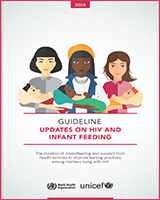Annex 5Questions and PICO used as the basis for preparing systematic reviews of the available published evidence
View in own window
| 1 | Question | For how long should a mother living with HIV breastfeed if she is receiving ART and there is no evidence of clinical, immune or viral failure?
What is the HIV-free survival of HIV-exposed infants according to feeding practices when mothers are taking ARV drugs? | Importance |
|---|
| Population | Infants of mothers living with HIV | Critical |
| Intervention | Breastfeeding and maternal ARV drugs |
| Comparison | Not breastfeeding or early cessation of breastfeeding
No maternal ARV drugs |
| Outcome | HIV transmission and HIV-free survival between birth and 24 months |
|
| 2 | Question | Can facility-and community-based interventions improve the quality of breastfeeding practices among mothers living with HIV? | Importance |
|---|
| Population | Mothers living with HIV receiving ARV drugs | Important |
| Intervention | Support and counselling delivered by facility-based or community-based health workers or peers (people living with HIV in the same community) |
| Comparison | Standard care without support |
| Outcome |
Exclusive breastfeeding (three months and six months) Initiation of breastfeeding Early initiation of breastfeeding (within one hour of birth) Safe replacement feeding
|
|
| 3 | Question | If a mother living with HIV does not exclusively breastfeed, is mixed feeding with ART better than no breastfeeding at all?
Are ARV drugs effective in preventing the postnatal transmission of HIV through breast milk according to feeding modality? | Importance |
|---|
| Population | Infants of mothers living with HIV receiving ARV drugs | Critical |
| Intervention | Exclusive breastfeeding |
| Comparison | Mixed feeding |
| Outcome | HIV transmission and HIV-free survival |
|
| 4 | Question | If a mother living with HIV plans to return to work or school, is a shorter duration of planned breastfeeding with ART better than no breastfeeding at all?
What is the HIV-free survival of infants breastfed for durations less than 12 months compared to breastfeeding for 12 months? | Importance |
|---|
| Population | Infants of mothers living with HIV receiving ARV drugs | Critical |
| Intervention | Breastfeeding for 12 months |
| Comparison | Earlier cessation of breastfeeding |
| Outcome | HIV-free survival |
The Guideline Development Group also suggested examining the implications of updated recommendations on two programmatic areas:

